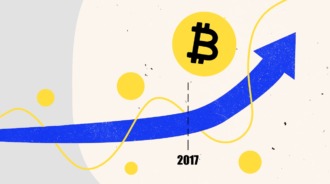

Through time, India has always embraced innovation and pioneered advancements across various domains. It is known as the Land of Many Firsts, and India’s legacy extends from introducing algebra to the world to inventing ancient board games like Snakes & Ladders. Today, this legacy of innovation is converging with modern financial practices.
Blockchain technology ushers in a new era of transformation within the lending ecosystem. And India is once again at the forefront of change, so let’s see what it’s all about.
Key trends driving the lending industry
Image 1
The lending industry in India is being propelled forward by key technological trends, with blockchain in fintech serving as a critical enabler.
Let’s delve into the context that has fueled the rise of blockchain lending:
- India’s push towards digitization and modernization of financial services aligns with the adoption of blockchain lending.
- The country boasts a rapidly growing population of tech-savvy individuals who are increasingly comfortable with digital platforms.
- A substantial portion of India’s population lacks access to formal credit. Blockchain lending can address this gap by providing creditworthy individuals and small businesses with an alternative source of funding.
- The regulatory bodies have shown interest in understanding and regulating blockchain technology.
- The success of blockchain in various sectors, such as supply chain management and healthcare, has inspired confidence in its applicability to lending.
Globally, debt has played a great role in propelling economic growth by facilitating investments, consumption, and business expansion. In India, this principle holds true as well. And there is room for the country to responsibly take on additional debt to fund various developmental initiatives and other growth-oriented activities. Prudent borrowing can contribute to increased investment, job creation, and the overall improvement of economic conditions.
Overall, the prevailing factors and circumstances create a robust set of tailwinds.
The shift: India’s lending ecosystem in 2023
With the emergence of new digital lending enterprises within India, the country has witnessed an impressive CAGR of 39.5% over the span of a decade. And, as you already know, a number of factors are hinting at a promising trajectory ahead. Projections from industry experts underscore the potential of the digital lending market — $515 billion valuation by the year 2030, as highlighted in the latest report by IIFL FinTech.
To achieve this, banks will need to collaborate with emerging players within the blockchain lending landscape. These collaborations will allow traditional financial institutions to rapidly integrate innovative technologies, including smart contracts and digital identities, into their lending operations.
However, there is ample room for the increased adoption of digital technologies. While the digital lending industry is making remarkable strides, approximately 60% of the rural population in India is yet to actively embrace the internet. Many individuals continue to opt for conventional and time-consuming methods of conducting business. And this proves once again that bridging the digital divide is still an essential goal.
Peer-to-peer lending: a boon for borrowers and lenders
Spearheaded by pioneering fintech lending companies in India, like PayTM, Lendingkart, InCred, and more, the country has witnessed a remarkable transformation in how lending is conducted. P2P lending represents a departure from the familiar lending methods — it facilitates direct connections between individuals seeking loans and those looking to invest. Here is how this approach is proving to be a game-changer for borrowers and lenders alike.
For borrowers, the process of blockchain lending involves creating loan listings that outline their funding requirements and the intended use of the cryptocurrency. Borrowers specify the amount of digital assets they need and provide insights into the purpose behind their borrowing endeavor. This information is vital in enabling potential lenders to gauge the borrower’s needs and assess the risk associated with the loan.
Lenders, on the other hand, assume the role of decision-makers in the process. They review the diverse loan listings available and make informed choices regarding which loans to fund. Lenders take into account such factors as the offered interest rates and the assessed risk levels of the borrower. This assessment allows lenders to align their investments with loans that meet their financial objectives while considering the degree of risk they are comfortable with.
Once a loan listing garners sufficient funding from lenders, borrowers receive the agreed-upon amount of funds in their digital wallet. This symbiotic relationship shapes the landscape of new-age lending.

Benefits of blockchain-powered lending platforms
Image 2
Here are the benefits that challenge the conventional norms of borrowing and lending.
Transparency and trust
Blockchain-powered lending platforms introduce transparency through their decentralized and tamper-proof ledger. This ensures that all transactions, from loan origination to repayment, are recorded and visible to all parties involved. In a country where trust in financial institutions can sometimes be a concern, confidence requires this level of transparency.
Streamlined credit evaluations
Conventional credit evaluation processes can be time-consuming and cumbersome, and they often rely heavily on traditional credit scores that might exclude segments of the population. Blockchain has the potential to transform this by leveraging decentralized identity systems and smart contracts.
These platforms gather verified data from various sources, including utility bill payments, digital transactions, and more, to create a holistic and accurate credit profile. As a result, credit evaluations take a fraction of the time.
Access and convenience
India’s vast and diverse population often faces challenges in accessing formal financial services, particularly in rural areas. Blockchain-powered lending overcomes geographical barriers — it makes borrowing and lending accessible to individuals regardless of their location. Also, it offers the convenience of submitting applications, receiving funds, and managing repayments from the comfort of one’s home.
Fair interest rates
Interest rates have been a point of contention in the lending landscape. In the traditional arrangement, borrowers face high rates due to a lack of competition and transparency. Blockchain platforms disrupt this pattern by facilitating direct peer-to-peer lending. This cuts out intermediaries and allows borrowers to connect directly with lenders, which translates to more competitive and fair interest rates.
Challenges and future outlook
Drawing insights from real-world experiences, Deloitte shed light on the challenges that businesses encounter in the realm of blockchain technology:
- Lack of internal awareness. Companies should take the initial step of forming internal teams dedicated to understanding blockchain’s impact and possible use cases.
- Identification of business cases and partners. Organizations need to establish cross-functional teams to deliberate on potential use cases.
- Development environment and security issues. Data security measures, such as encryption and controlled data access, need to be implemented to safeguard sensitive information.
As for users, their challenges come down to user education and familiarity, usability and user experience, transaction speed and cost, and key management.
Bear in mind that challenges are more pronounced in the adoption phase rather than the subsequent implementation. For now, the triumph of blockchain lending depends on how agile and responsive industry players are to capitalize on the technology’s benefits and the level of support they garner from stakeholders.
If the rise of blockchain resonates with you, perhaps you’ll also find interest in exploring the world of crypto trading on Binomo — this is where innovation meets opportunity in the rapidly evolving landscape of digital finance.
Sources:
The rise of alternative lending, PwC India
India’s digital lending market likely to grow $515 bn by 2030: Report, Economic Times BFSI
Lending market in India – statistics and facts, Statista
Blockchain technology in India: opportunities and challenges, Deloitte









